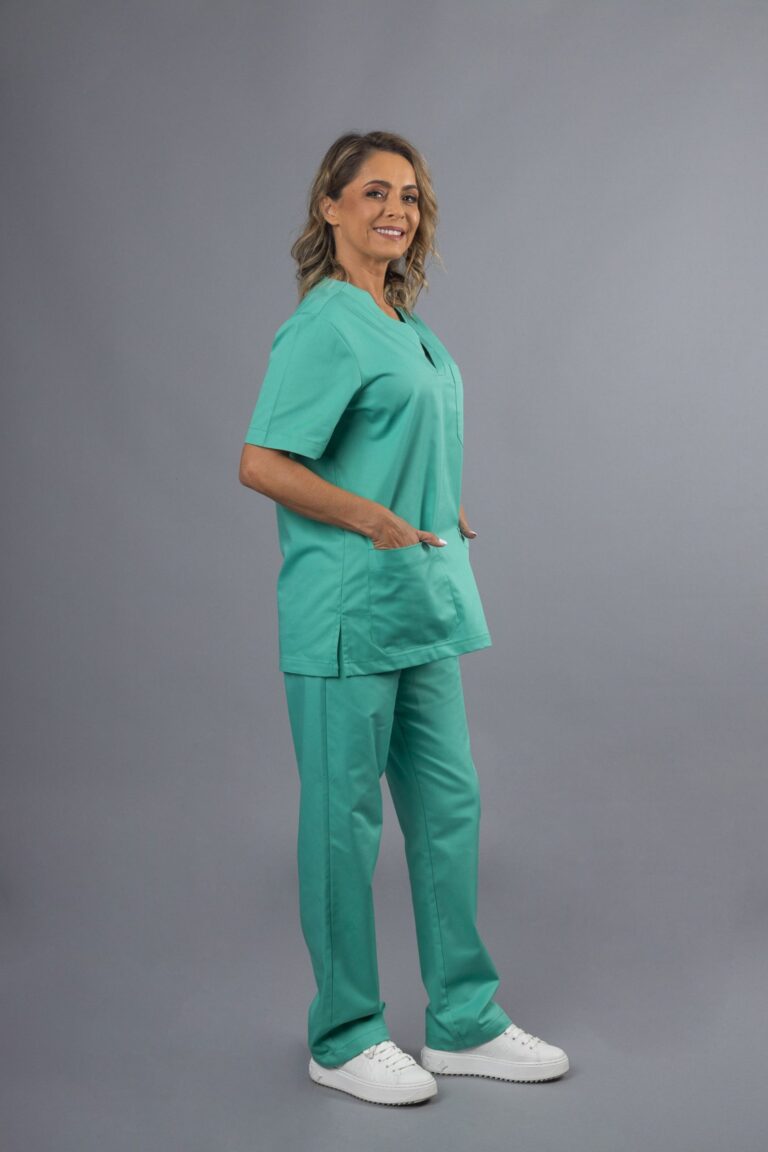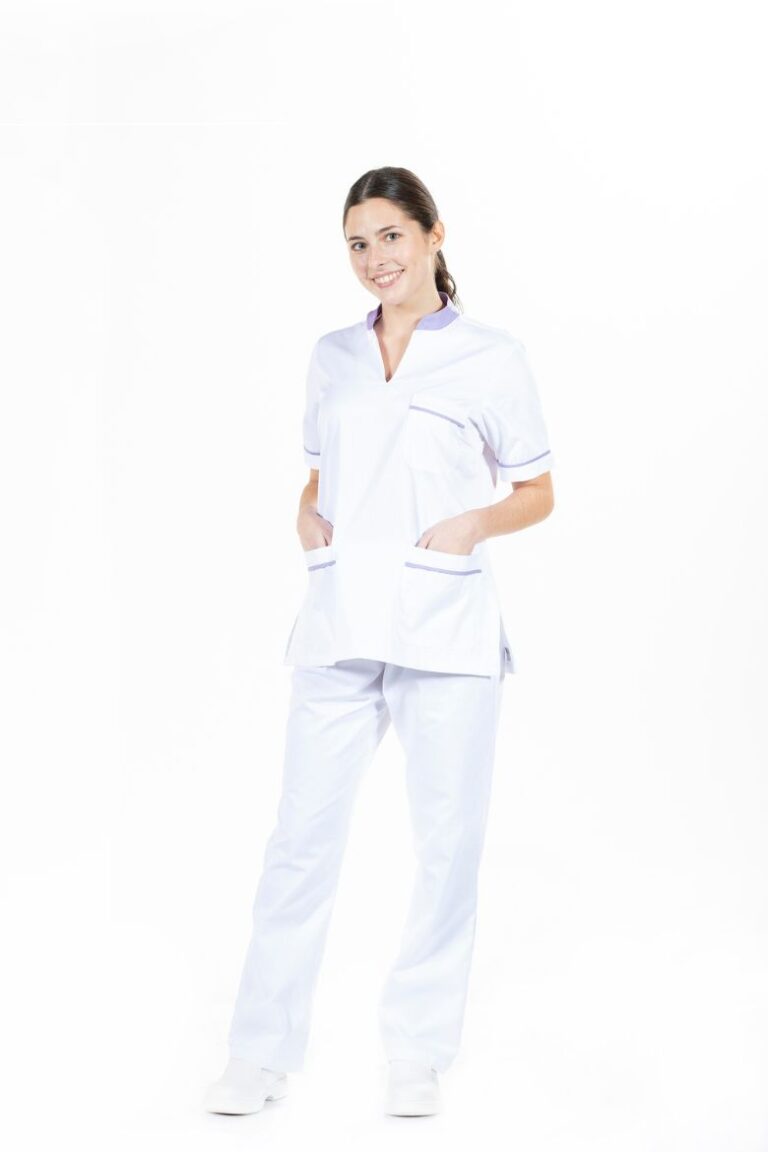

















Products with visible prices are those that can be purchased immediately, online, without requiring minimum purchase quantities. This means you can explore our variety of options and purchase exactly what you need, with complete transparency regarding costs and the Professional Apparel model. On the other hand, products without a listed price function as a portfolio of possibilities. These items are highly customizable and can be tailored to each customer's individual specifications. To ensure quality and meet expectations, these products have a minimum order quantity and are subject to a custom quote process.
There are several different types of nursing uniforms, and the choice depends on the healthcare institution’s policy, personal preferences, and specific job requirements. Here are some of the most common types of nursing uniforms: • Standard Uniform/Hospital Scrubs: This is the traditional nursing uniform, typically consisting of a set of a top or shirt and pants. Colors and styles can vary by institution but are generally in shades of blue, green, or white. • Surgical Scrubs: These uniforms are designed for use in surgical environments and are often made from materials resistant to fluids and stains. They may also include surgical gowns. • Pediatric Scrubs: For those working with children, it may be appropriate to wear colorful uniforms or ones with child-friendly prints to create a more welcoming environment.
Wearing the right clothing underneath your nursing uniform is essential for ensuring comfort during long shifts. Here are some recommendations for what you can wear underneath your nursing uniform for greater comfort: • Cotton Undershirt: A cotton undershirt can be a smart choice to wear underneath the uniform. It helps absorb sweat and keeps you more comfortable throughout your shift. Other options to consider include moisture-wicking fabrics, thermal layers for colder environments, and seamless or tag-free undergarments to prevent irritation.
Choosing the most suitable nursing uniforms can be a complex task due to the various factors to consider. These include selecting the correct sizes, appropriate types of fabrics, finishes, functionalities, designs, and other aspects that, when chosen according to your staff’s needs, will provide them with numerous benefits.
Nursing uniforms should be developed and manufactured to offer maximum comfort, protection, and mobility, allowing healthcare professionals to perform their duties without any restrictions. Many healthcare institutions use uniforms in different colors to identify various specialties. Another very important aspect is effective protection against bacteria and other types of germs. This additional protection benefits both healthcare professionals and patients.
What is the importance of nursing uniforms?
In the healthcare sector, the use of appropriate nursing uniforms is extremely important. Nursing uniforms protect healthcare professionals from contaminants. Each work uniform has its specific purpose and should be designed with the context and workspace where it will be used in mind. Healthcare uniforms are a crucial component in providing proper care and offer the following benefits to users:
• Provide Adequate Protection: They offer protection against bodily fluids.
• Cost-Effective and Durable: These nursing uniforms are designed for maximum use and cost-efficiency.
• Comfort and Mobility: They ensure comfort and freedom of movement for the wearer.
• Functionality: They are highly functional.
• Easy Identification: They make healthcare professionals easily identifiable.
• Protection Against Cross-Contamination: Healthcare uniforms help prevent cross-contamination.
What Are the Most Common Colors in Nursing Uniforms?
Color is a powerful means of communication, capable of conveying sensations, values, and even moods. The clothing we wear speaks volumes about us, reflecting our personality and character. This detail becomes even more significant when it comes to nursing uniforms, as they convey a message about the institution and its brand values.
The color of nursing uniforms should reflect the essence and personality of the healthcare institution. In some professions, this factor is more influential than in others, and in the healthcare sector, the emotional impact of color is quite pronounced.
Although various colors are now used in medical uniforms, including gray, navy blue, pink, and yellow, the most common colors are blue, green, and white.
But what do these colors signify?
Colors of Nursing Uniforms and Their Meanings
• White: White is the color traditionally associated with the healthcare sector, whether in lab coats or surgical scrubs. It is a symbol of purity, cleanliness, and hygiene, conveying a sense of order and professionalism.
• Blue: Blue is one of the most common colors in healthcare uniforms. It is the color of the sea, evoking tranquility and relaxation, as well as conveying a sense of protection and confidence. The chosen shade of blue can influence perception; light blue tends to convey calmness, while navy blue is associated with elegance and sobriety.
• Green: Green is widely used in surgical environments. Traditionally, it is associated with serenity and relaxation, helping to reduce visual fatigue and glare that doctors face during operations. Additionally, green helps to minimize the reflection produced by surgical lights on tissues.
Benefits of Crepe Fabric for Nursing Uniforms
Crepe fabric, derived from the French word “Crêpe,” meaning “crinkled,” is a lightweight and textured material characterized by small ripples. Here are some of the benefits of crepe fabric for nursing uniforms:
• Lightweight: Crepe fabric is lightweight, providing comfort during long working hours and contributing to a feeling of freshness and softness.
• Texture: The textured nature of crepe gives an elegant and distinctive appearance, with variations ranging from textured to smoother and more uniform surfaces.
• Durability and Maintenance: It is a material that tends to retain its shape and appearance after multiple washes, being easy to care for and resistant to wrinkling.
• Comfort: The lightness and texture of crepe contribute to superior comfort, which is important for the efficient performance of daily functions by healthcare professionals.
Fardamento à sua medida.
Descubra as nossas
soluções.
Fardamento à sua medida.
Descubra as nossas
soluções.
To subscribe, please enter your e-mail address and click on “Subscribe”.
You can stop receiving our communications by clicking on the link in the footer of any of our newsletters.
Para efetuar a sua subscrição, por favor insira o seu e-mail e clique em “Subscrever”.
Poderá parar de receber as nossas comunicações, ao clicar no link para o efeito encontrado nos rodapés de qualquer uma das nossas Newsletters.
UNIFARDAS® supports Espaço T, which is an inclusive organisation, of all and for all, and our common goal is to increase employment opportunities for young people with special needs and/or who, for some reason, have been excluded from the labour market.
We work hard to provide safe working conditions by going beyond the imposed and mandatory minimums.
We support, nurture and offer continuous training programmes aimed at improving skills.
At UNIFARDAS® we keep up to date with the latest technologies and innovations that can optimise our production process making it more efficient and close to zero waste.
UNIFARDAS® is a partner of Espaço T, an inclusive organisation, of all and for all, with the common goal of increasing employment opportunities for young people with special needs and/or who, for some reason, have been excluded from the labour market. In this organisation, immigrants will also find a support network in finding work and housing.
In addition to the sustainable path we have been taking throughout our production and supply chain, UNIFARDAS® participates, supports and organises a beach clean-up every year after the bathing season, in partnership with World Clean-up Day. We are also partners of Seaqual, an entity that, together with some other partners, promotes the collection of ocean waste and its transformation into upcycled marine plastic that will then be used in the production of fabric and other sustainable products.
In addition to the sustainable path we have been taking throughout our production and supply chain, UNIFARDAS® participates, supports and organises a beach clean-up every year after the bathing season, in partnership with World Clean-up Day. We are also partners of Seaqual, an entity that, together with some other partners, promotes the collection of ocean waste and its transformation into upcycled marine plastic that will then be used in the production of fabric and other sustainable products.